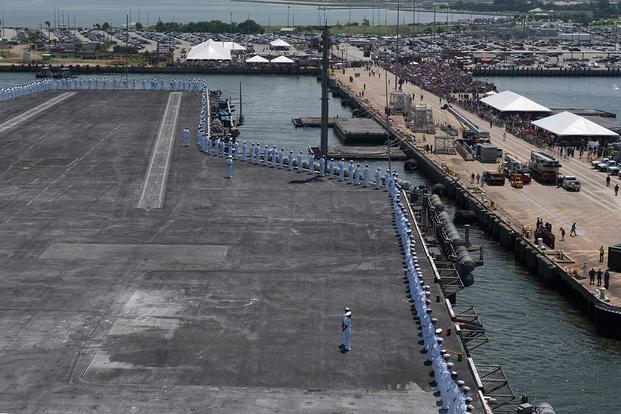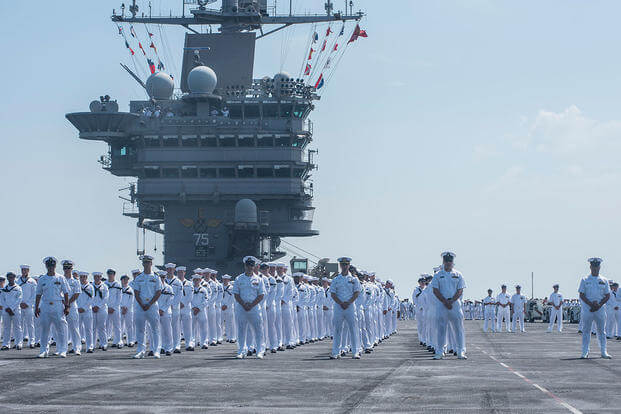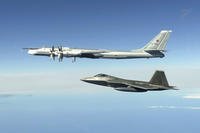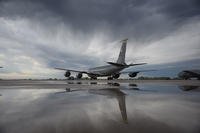NORFOLK, Va. — Approximately 6,000 Sailors from Carrier Strike Group (CSG) 8 returned home July 13, after completing an eight-month combat deployment.
Aircraft carrier USS Harry S. Truman (CVN 75) with embarked CSG 8 staff, Carrier Air Wing (CVW) 7, guided-missile cruiser USS Anzio (CG 68), Destroyer Squadron (DESRON) 28 staff and guided-missile destroyers USS Bulkeley (DDG 84), USS Gonzalez (DDG 66) and USS Gravely (DDG 107) pulled into Naval Station Norfolk following an extended deployment to the 5th and 6th Fleet areas of operation in support of Operation Inherent Resolve (OIR), maritime security operations and theater security cooperation efforts. USS Ramage (DDG 61) remains deployed and will return to Norfolk later this month.
The deployment is credited with supporting U.S. strategy to degrade the Islamic militant group, ISIL. "We received the best training in the world prior to deployment and were extraordinarily fortunate with the opportunities that presented themselves over the course of the last eight months. Being a part of this team, with the standards of professionalism sustained across the entire crew, is something I will remember and cherish for the rest of my life," said Rear Adm. Bret Batchelder, commander, Carrier Strike Group 8.
As a result of OIR missions, analysts report a significant reduction in funding operations and estimate up to 45 percent of territory in Iraq and 20 percent in Syria has been seized from the terrorist force.
"Throughout deployment, more than 200 days at sea, the crew excelled in every opportunity to deliver direct and positive effects in theater, especially during Operation Inherent Resolve," said Capt. Ryan B. Scholl, Truman's commanding officer. "I couldn't be more proud of their performance."
Truman, the carrier strike group's flagship, began deployment conducting integrated carrier operations with the French Navy's Charles de Gaulle Strike Group over a six-week period in the Arabian Gulf.
During the coalition fight against ISIL, Truman and embarked CVW-7 completed 2,054 combat sorties, expending 1,598 pieces of precision ordnance--the most carrier-based ordnance throughout OIR--to degrade ISIL resources and leadership. "The close-air-support sorties we conducted supported coalition forces, taking the fight to ISIL," said Capt. David Little, commander, CVW-7. "By engaging dynamic terrorist targets and delivering precision guided ordnance we contributed significantly to the coalition goals of ultimately destroying ISIL."
Anzio, commanded by Capt. Frank Castellano, served as Air-Missile Defense Commander and expertly managed the congested battle space in the Arabian Gulf to enable uninterrupted air strikes in support of OIR. "The technology employed on board escort vessels, such as Anzio, allowed for early and accurate identification of inbound air traffic," said Castellano. "This early identification enabled prompt de-confliction and appropriate action, if required, to ensure the safety and security of U.S. and partner forces operating in the region."
Strike group destroyers performed escort and maritime interdiction missions as well as seven partnership-enhancing exercises. In addition, Gravely partnered with patrol ship USS Sirocco (PC 6) to seize more than 1,500 suspected Iranian arms in transport to Houthi Rebels in Yemen.
"The destroyers operating in Destroyer Squadron (DESRON) 28 conducted operations across a dispersed area, in support of OIR, theater security cooperation, and other national missions," said Capt. Derek Lavan, commander, DESRON-28. "In addition to escort duties for Truman, they demonstrated the Navy's flexibility and adaptability by successfully conducting simultaneous operations in the 5th and 6th Fleet areas of operation."
In June, the strike group disaggregated to support OIR from both the Arabian Gulf and the Mediterranean Sea - marking the first time during OIR a U.S. carrier conducted air strikes from the Mediterranean. Although separated by distance, the strike group remained connected through seamless communications.
"I'm extremely proud of the Combat Systems and Information Operations teams that performed brilliantly during deployment," said Capt. Rod Burley, information warfare commander. "Their efforts provided, by far, the best off ship connectivity I've experienced on any deployment. Individual unit teams worked around the clock to ensure networks were secure, protected, and defended."
"The strike group was successful not only because of its exceptional Sailors, but because we were all part of a larger team effort," said Batchelder. "We had incredible collaboration across 65 nations and our joint partners, specifically the Combined Air and Space Operations Center, which is a testament to the global priority of OIR."
The squadrons of CVW-7 include the California-based "Wallbangers" of Carrier Airborne Early Warning Squadron (VAW) 117, the "Fist of the Fleet" of Strike Fighter Squadron (VFA) 25, and the "Patriots" of Electronic Attack Squadron (VAQ) 140; the Virginia Beach-based "Rampagers" of VFA-83, the "Jolly Rogers" of VFA-103, the "Pukin' Dogs" of VFA-143, the "Rawhides" of Fleet Logistics Support Squadron (VRC) 40 and the "Nightdippers" of Helicopter Sea Combat Squadron (HSC) 5; and the Florida-based "Proud Warriors" of Helicopter Maritime Strike Squadron (HSM) 72.
Batchelder summarized the feelings of the strike group's Sailors as CVW-7 launched their fly-off: "We can't thank our families and friends adequately for the love and support they provided over the entire deployment. They are patriots in the truest sense of the word and our many successes were built on their sacrifices and the strength they provided each and every day."
Air Wing aircraft returned to their home stations July 12.































